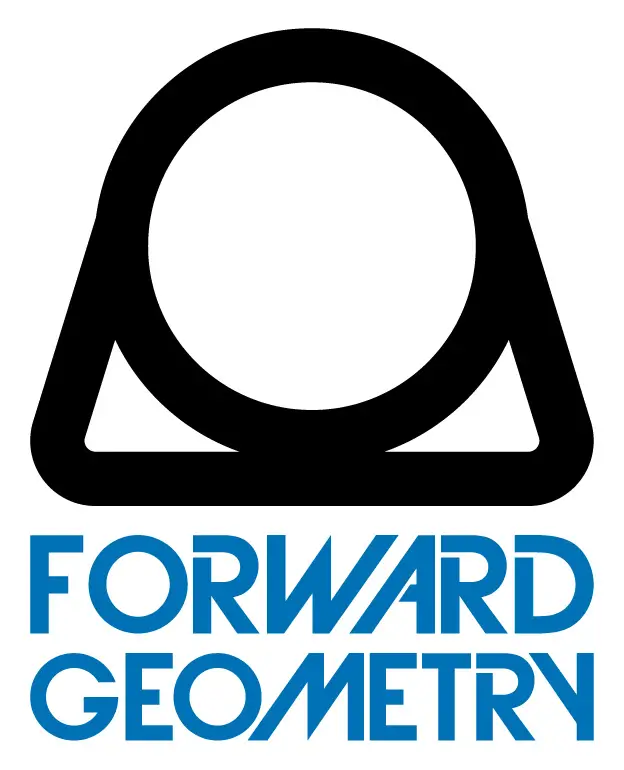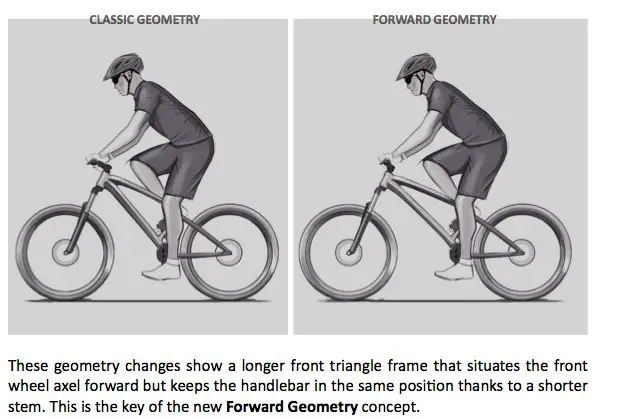
Well I’m sure you’ve seen it around on the internet over the last year or so (or maybe you haven’t…); Fabien Barel’s prototype Mondraker with the decidedly odd-looking front end. Early prototypes were ridden last year at the Trans-Provence by one of the designers behind the concept; Cesar Rojo, and few weeks ago we were lucky enough to get a morning’s riding on it.
First of all though, an explanation from Mondraker as to the thinking behind it.
Forward Geometry vs Classic Geometry
{Begin marketing speak}
“The best way to understand the geometry changes is to compare directly with a conventional one. Foxy XR will be the flagship of the new Forward Geometry concept and it is the best model to compare lengths and angles between both geometries, the Foxy series represents our best sellers due the pure versatility of these All Mountain models.

The new Foxy FG has a 60mm longer top tube, and as a result, a 60mm longer front-center because the head angle remains the same
60mm longer top tube + 10mm stem length of the new Foxy FG = the same length that the 70mm old stem length of Foxy with classic geometry.
The Foxy FG and standard Foxy have the same distances between bottom bracket, saddle and handlebar, this means the same perfect pedalling position for both Foxys.
The overall geometry is maintained on both Foxys if we use the same 140mm fork length
68º head angle
75º seat tube angle
430mm chain stay length
0 mm BB drop
These geometry changes show a longer front triangle frame that situates the front wheel axle forward but keeps the handlebar in the same position thanks to a shorter stem. This is the key of the new forward geometry concept.

Forward Geometry advantages
Security in steep areas
The front axle is more advanced {as in further forward} that in any other geometry making it almost impossible to go over the bars in steep sections, it feels more secure and confident due to the slacker angle perception making your ride more confident and faster.
Confidence at high speed
The longer wheelbase makes the bike much more stable over any terrain
Uphill precision
The front wheel keeps the contact on the ground avoiding wheelies due the longer front-center length
Stability on rough sections
The FG gives a new weight balance between front and rear wheel making it possible to load the front wheel a lot more than with a classic geometry. This changes your handling, giving better grip in cornering and improving control
Direct steering
The short 10mm stem allows a lot less handlebar movement to get the same front wheel angle. This improves the steering precision and makes the bike very reactive despite the longer wheelbase.

To sum up, the new Forward Geometry offers new sensations for any category. After a short accommodation period to the bike handling, the overall control improves more than you can imagine. The new geometry makes your riding more stable, reactive and confident, giving you the chance to go faster.”
{end of marketing speak}
In a nutshell then, Mondraker is trying to marry the stability of downhill bikes with agility of XC bikes in a pedalable package. In many ways, despite the crazy look of the bike, it’s what many riders have been doing with their own bikes to lesser degree in the last few years; maybe going up a size to get a longer top tube, and then running a shorter stem and wider bars, and perhaps then adding a angle-set as well (slacker also equals longer)
The bikes we were riding were Foxys with 36s on the front so they were probably a degree or so slacker than a Foxy with 150mm or 140mm forks.

Premier users can find out what Matt’s first thoughts on the bikes are below.
If you’re not Premier, you can sign up for as little as £2 a month. Or simply subscribe to Singletrack and get automatic Premier membership.
This content is exclusive for Premier users.
If you are a Subscriber log in.
Subscriptions start from just £1.99
All images (apart from the mud bath ) Courtesy of Sebastien Boue
For more info either check Mondraker’s own site
Or Plymouth’s finest. Silverfish






Sounds like a well set up slack 29er should
feel but with dodgier climbing handling 😉
ok, silly question of the week, but why did bikes develop with stems anyway? Why weren’t the bars mounted directly on the steerer from the beginning? Anyone know?
So longer top tube and shorter stem. A bit like what gary fisher did then
Not really Juan. Well not to that level anyway ; ] Old Rotec Dh bikes would be fairer. http://i3.photobucket.com/albums/y81/cakefan/Rotec/HPIM2222.jpg
Finally someone has decided to sack up & produce a trail bike designed around a properly long toptube/short stem/slack head angle combination without getting their self in a twist over what people will will think about the wheelbase.
I’m with mos!
Having owned a Foxy that was a bit too long for me and put a short stem on it, I have an inkling what these might ride like (incredible stability) but I’d love a go on one.
Hmm, interesting… I think it sounds good, and at least it would look different from all the other stuff!
I could be in trouble with the mrs again.
Looks interesting. Lots of us (short arm midgets like me especially) try to achieve this by putting on longer forks and shorter stems. I’m sure it makes a whole different ride. But, can’t help being reminded of Rob Warner’s comment about bike innovation being little more than ‘Mine’s bigger than yours’. Bar size, headtube size, travel size, axle size, cassette size, wheel size and now wheelbase size!
Definitively spot on for a “fun bike”!! But I think you may be giving some if you have tricky, steep climbs.
It all depends on preference and terrain, really. There’s a point where a bike becomes too slack and long for certain terrain.